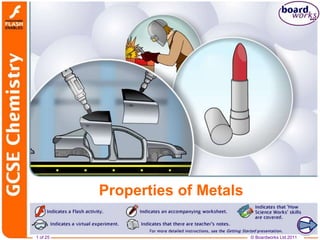More Related Content
Similar to properties_of_metals.ppt (20)
properties_of_metals.ppt
- 1. 1 of 25 © Boardworks Ltd 2011
Properties of Metals
- 3. 3 of 25 © Boardworks Ltd 2011
Uses of metals
How many different uses of metal can you spot?
- 4. 4 of 25 © Boardworks Ltd 2011
The value of metals
Metals are a highly valuable group of materials, used for
hundreds of products and produced in huge quantities.
36,900,000 tons of aluminium
were produced in 2009.
The production of copper
increased by more than
20 times in the 20th century.
Gold is worth more than
£27,000 per kilogram.
Metals have played a vital role in human development.
Periods of civilization are even classified by the metals
that were used during those times, such as the Iron Age.
- 5. 5 of 25 © Boardworks Ltd 2011
Properties of metals
Typical metals have a lot of physical properties in common.
They:
are lustrous (shiny)
have a high density
are good conductors of
heat and electricity
have high melting and
boiling points (except
mercury, which is liquid at
room temperature).
are hard and strong
are malleable (can be bent
and pressed into different
shapes) and ductile (can be
drawn into wires)
- 6. 6 of 25 © Boardworks Ltd 2011
Au, Al, Cu, Fe and Ti
- 7. 7 of 25 © Boardworks Ltd 2011
Testing properties
- 8. 8 of 25 © Boardworks Ltd 2011
Other uses of metals
It is easy to find products made from metals, but some uses
of metals are not so widely known.
Compounds containing metals have
many uses. For example, some metal
compounds are used to colour materials
such as stained glass, and even make-up.
Metals are used as catalysts to
speed up reactions. Nickel is used
as a catalyst to make margarine.
Platinum is used in catalytic
converters in car exhausts to clean
up fumes and reduce pollution.
Can you find any other uses of metals?
- 9. 9 of 25 © Boardworks Ltd 2011
Building cars
- 10. 10 of 25 © Boardworks Ltd 2011
Aluminium or steel?
Aluminium and steel (an alloy of iron) can both be used to
make car bodies, but they have some different properties.
aluminium steel
density?
magnetic?
corrodes?
malleable?
yes
no
no yes
low high
yes
yes
Steel is significantly cheaper to produce than aluminium,
so a car made from steel will cost a lot less to produce,
resulting in a lower purchase price for the consumer.
- 11. 11 of 25 © Boardworks Ltd 2011
Aluminium or steel?
The mass of a car body which is made from aluminium will
be less than the mass of a car body made from steel.
Using a lighter car body will increase the fuel economy
and performance of the car as the engine will have to do
less work to make the car move.
A car made from steel will rust if the paintwork is damaged
or worn, whereas a car made from aluminium will not.
However, advances in anti-
corrosion coatings mean that
with normal use it is a number of
years before the body of a steel
car usually rusts significantly.
- 12. 12 of 25 © Boardworks Ltd 2011
The importance of properties
- 14. 14 of 25 © Boardworks Ltd 2011
Where are the transition metals?
The transition metals are the block of elements found
between group 2 and group 3 of the periodic table.
group 2 group 3
transition metals
- 15. 15 of 25 © Boardworks Ltd 2011
Common transition metals
- 16. 16 of 25 © Boardworks Ltd 2011
Iron vs. aluminium
- 18. 18 of 25 © Boardworks Ltd 2011
What is corrosion?
Corrosion is the gradual destruction of a metal due to
reactions with other chemicals in its environment.
Over time, corrosion
changes the appearance of
the metal as it breaks down
and becomes weaker.
Coating the surface of a metal
with paint and certain chemicals
can protect it from corrosion.
Corrosion can seriously damage
metallic objects and structures.
- 19. 19 of 25 © Boardworks Ltd 2011
Do all metals corrode?
Metals behave differently when
exposed to the environment.
Gold is an unreactive metal
and does not corrode easily.
Items made from gold can
survive for thousands of years
and have even been found in
good condition underwater.
A metal’s resistance to corrosion
is related to its position in the
reactivity series. The more
reactive a metal, the less
resistant it is to corrosion.
increasing
reactivity
potassium
sodium
calcium
magnesium
aluminium
zinc
iron
copper
gold
lead
silver
platinum
- 20. 20 of 25 © Boardworks Ltd 2011
What is rusting?
Acid rain and salt can increase the rate of rusting.
Rusting is the specific name given to the corrosion of iron.
It is a chemical reaction between iron, oxygen and water.
The chemical name for rust is hydrated iron (III) oxide.
Rusting is an example of an oxidation reaction.
Oxidation is the addition of oxygen to an element.
hydrated iron (III) oxide
water
+
+
iron oxygen
The opposite process, where oxygen is removed from a
compound, is known as reduction.
- 21. 21 of 25 © Boardworks Ltd 2011
Testing corrosion
- 22. 22 of 25 © Boardworks Ltd 2011
Why doesn’t aluminium corrode?
coating of
oxygen atoms
The outer aluminium atoms react with oxygen in the
atmosphere to form a thin layer of aluminium oxide on the
metal’s surface, which protects the metal from corrosion.
Aluminium is a very reactive metal. However, it does
not corrode in the presence of oxygen. Why is this?
oxygen in the
atmosphere
aluminium
atoms
- 24. 24 of 25 © Boardworks Ltd 2011
Glossary
- 25. 25 of 25 © Boardworks Ltd 2011
Multiple-choice quiz
